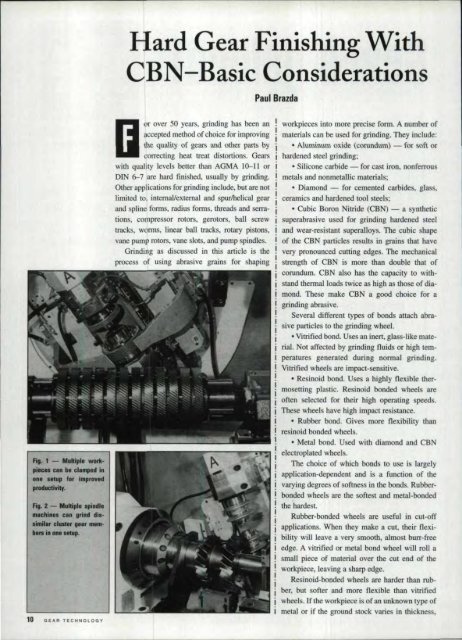Download the May/June 1998 Issue in PDF format - Gear ...
Download the May/June 1998 Issue in PDF format - Gear ...
Download the May/June 1998 Issue in PDF format - Gear ...
You also want an ePaper? Increase the reach of your titles
YUMPU automatically turns print PDFs into web optimized ePapers that Google loves.
... 1 -<br />
Multiple workp'-cn<br />
cln be clamped <strong>in</strong><br />
one letup for improved<br />
prodactlvity.<br />
Rg. Z - Multiple sp<strong>in</strong>dle<br />
... ch<strong>in</strong>n can gr<strong>in</strong>d dilsimi<br />
.. , c'UIIet gea' !Mm-<br />
..... <strong>in</strong> one SltUp.<br />
Hard <strong>Gear</strong> F<strong>in</strong>ish<strong>in</strong>g With<br />
CB,N-B,asic Considerations<br />
IJ<br />
'Or over 50 years, gr<strong>in</strong>d<strong>in</strong>g has been an<br />
accepted method of choice for improv<strong>in</strong>g<br />
me quality of gears and o<strong>the</strong>r parts by<br />
correct<strong>in</strong>g heat treat distortions. <strong>Gear</strong>s<br />
with quality levels better than AGMA 10-]] or<br />
DIN 6-7 are hard f<strong>in</strong>ished, usually by gr<strong>in</strong>d<strong>in</strong>g.<br />
O<strong>the</strong>r applications for gr<strong>in</strong>d<strong>in</strong>g <strong>in</strong>clude, but are not<br />
limited to. <strong>in</strong>ternal/external and spur/helical gear<br />
and spl<strong>in</strong>e forms, radius forms, threads and serrations,<br />
compressor rotors, gerotors, bail screw<br />
tracks, wonns, l<strong>in</strong>ear ball tracks, rotary pistons,<br />
vane pump rotors, vane slots, and pump sp<strong>in</strong>dles.<br />
Gr<strong>in</strong>d<strong>in</strong>g as discussed <strong>in</strong> this article is <strong>the</strong><br />
process of us<strong>in</strong>g abrasive gra<strong>in</strong>s for shap<strong>in</strong>g<br />
Paul Brazda<br />
workpieces <strong>in</strong>to more precise form. A number of<br />
materials can be used for gr<strong>in</strong>d<strong>in</strong>g. They <strong>in</strong>clude:<br />
• Alum<strong>in</strong>um oxide (corundum) - for 'soft.or<br />
hardened steel gr<strong>in</strong>d<strong>in</strong>g;<br />
• Silicone carbide - for cast iron, nonferrous<br />
metals and nonmetallic materials;<br />
• Diamond - for cemented carbides, glass,<br />
ceramics and hardened tool steels;<br />
• Cubic Boron Nitride (CBN) - a. syn<strong>the</strong>tic<br />
superabrasive used for gr<strong>in</strong>d<strong>in</strong>g hardened steel<br />
and wear-resistant superalloys .. The cubic shape<br />
of <strong>the</strong> CBN particles results <strong>in</strong> gra<strong>in</strong>s that have<br />
very pronounced cutt<strong>in</strong>g edges. The mechanical<br />
strength of eON is more than double that of<br />
corundum. eRN also has <strong>the</strong> capacity to withstand<br />
<strong>the</strong>rmal loads twice as high as those of diamond,<br />
These make eBN a good choice for a<br />
gr<strong>in</strong>d<strong>in</strong>g abrasive.<br />
Several different types of bonds attachabrasive<br />
panicles to <strong>the</strong> gr<strong>in</strong>d<strong>in</strong>g wheel.<br />
• Vitrified bond. Uses an <strong>in</strong>ert" glass-like material<br />
Not affected by gr<strong>in</strong>d<strong>in</strong>g fluids or high temperatures<br />
generated dur<strong>in</strong>g normal gr<strong>in</strong>d<strong>in</strong>g.<br />
Vitrified wheels are impact-sensitive.<br />
• Res<strong>in</strong>oid bond, Uses a hlghly flexible <strong>the</strong>rmosett<strong>in</strong>g<br />
plastic. Res<strong>in</strong>oid bonded wheels are<br />
often selected for <strong>the</strong>ir high operat<strong>in</strong>g speeds.<br />
These wheels have high impact resistance.<br />
• Rubber bond. Gives more flexibility than.<br />
res<strong>in</strong>oid bonded wheels .<br />
• Metall bond. Used wi.th diamond and eBN<br />
electroplated wheels.<br />
The choice of which bonds to use is Largely<br />
application-dependent and is a function of <strong>the</strong><br />
vary<strong>in</strong>g degrees of softness <strong>in</strong> <strong>the</strong> bonds. Rubberbonded<br />
wheels are <strong>the</strong> softest and metal-bonded<br />
<strong>the</strong> hardest.<br />
Rubber-bonded wheels are useful <strong>in</strong> cut-off<br />
applications. When <strong>the</strong>y make a cut, <strong>the</strong>ir flexibility<br />
will leave a very smooth, almost. burr-free<br />
edge. A vitrified or metal bond wheel will roll a<br />
small piece of material over <strong>the</strong> cut end of <strong>the</strong><br />
workpiece, leav<strong>in</strong>g a sharp edge.<br />
Res<strong>in</strong>oid-bonded wheels are harder than rubber,<br />
but softer and more flexible than vitrified<br />
wheels. If <strong>the</strong> workpiece is of an unknowntype of<br />
metal or if <strong>the</strong> ground<br />
stock varies <strong>in</strong> thickness.

















